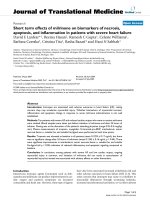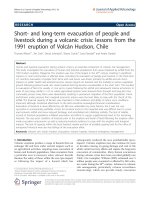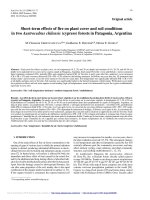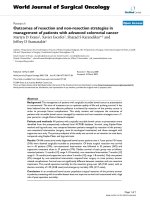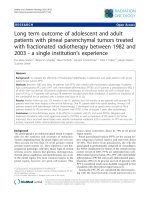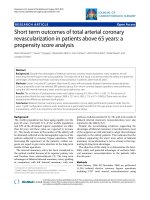Short term outcomes of laparoscopic left lateral sectionectomy for hepatocellular carcinoma treatment in department of hepatobiliary and pancreatic surgery – national cancer hospital
Bạn đang xem bản rút gọn của tài liệu. Xem và tải ngay bản đầy đủ của tài liệu tại đây (380.17 KB, 5 trang )
Short-term outcomes of laparoscopic left
Bệnh
lateral
viện sectionectomy...
Trung ương Huế
SHORT-TERM OUTCOMES OF LAPAROSCOPIC LEFT LATERAL
SECTIONECTOMY FOR HEPATOCELLULAR CARCINOMA
TREATMENT IN DEPARTMENT OF HEPATOBILIARY AND
PANCREATIC SURGERY – NATIONAL CANCER HOSPITAL
Pham The Anh1, Nguyen Kieu Hung1,
Nguyen Truong Giang1, Nghiem Thanh Ha1, Pham Ba Duc1
SUMMARY
Background: Laparoscopic left lateral sectionectomy (LLLS) is indicated for liver tumors which locate
in easily accessible locations (left lateral section, left lobe, ...), with small sizes,... Feasibility, safety also
depend on surgeon skills, equipments.
Objectives: Evaluate short-term outcomes of LLLS to treat hepatocellular carcinoma.
Subjects and methods: a prospective cross-sectional study, including 13 patients who diagnosed
with hepatocellular carcinoma in left lateral section of the liver, was indicated with LLLS in Department of
Hepatobiliary and Pancreatic Surgery – National Cancer Hospital from 8/2018 to 4/2019.
Results: Male:female ratio is 5.49: 1. Mean age is 58.46 ± 8.67 years old (38 - 77 years old). 30.8% patients
have got hepatitis B virus. 46.2% patients have got alcoholism. 100% patients have Child - Pugh A. The
successful rate of LLLS is 100%. No intraoperative accidents are recorded. Mean operation time is 163.08
± 14.94 minutes (140 - 180 minutes). No patients need intraoperative blood transfusions. No postoperative
complications. Mean length of postoperative hospital stay is 7.54 ± 1.15 days (6-10 days). No postoperation
death within 30 days.
Conclusions: LLLS for hepatocellular carcinoma treatment is a simple, safe, highly feasible surgery
with low risk of complications, rapid postoperative recovery and a short hospital stay.
Keywords: Hepatocellular carcinoma, laparoscopic surgery, left lateral sectionectomy.
I. BACKGROUND
Hepatocellular carcinoma is a common malignant
disease in Vietnam and around the world. It is related
to hepatitis B, C virus infection, alcoholism,... with
high mortality rates. There are some manners
of treatment but liver resection is still the most
important and basic method. With improvement
of knowledges, equipments, laparoscopic surgery
is becoming more and more popular and bring
many benefits to patients (postoperative pain relief,
shortened hospital stay, aesthetics, ...) with low
1. K Hospital, Hanoi
12
risks of complications and similar to open surgery.
Laparoscopic surgery is indicated for liver tumors
in an easily accessible location by laparoscopy
(left liver, left lobe of the liver, ...), with not too
largesizes, ... and becoming an internal trend of
hepatectomy gradually.
With above reasons, we performed this research
with 2 objectives:
1. Describle clinical and paraclinical characteristics of patients with laparoscopic left lateral
sectionectomy (LLLS) for hepatocellular carci-
Corresponding author: Pham The Anh
Email:
Received: 9/5/2019; Revised: 17/5/2019
Accepted: 14/6/2019
Journal of Clinical Medicine - No. 54/2019
Hue Central Hospital
noma treatment.
2. Evaluateshort – term outcomes of laparoscopic left lateral sectionectomy (LLLS) for hepatocellular carcinoma treatment.
II. SUBJECTS AND METHODS
2.1. Subjects: From 8/2018 to 4/2019, there
are 13 patients underwent LLLS for hepatocellular
carcinoma treatment.
2.2. Methods
* Research design: prospective descriptivecrosssectional study.
* Techniques
- Positions: Patientsare are in supine position.
Surgeon stands in right side of patients. First
assistant stands in same side with surgeon and holds
camera, second assistant stands in opposite side.
- Set up trocars: we usually use 4 to 5 trocars
with 1 trocar 11mm just above umbilicus to insert
Camera; 1 trocar 12mm in right side to insert
Stapler, CUSA; 1 trocar 5mm just below right costal
margin; 1 trocar 5mm just below left costal margin
and 1 trocar 5mm on the right side, just below the
umbilicus (we use 5th trocar in 8 recent patients to
clamp the pedicle Glissonean pedicle outside the
abdomen with a Kelly pince).
- Inflate: we pump carbon dioxide into abdomen
with pressure< 12mmHgand rate of 2.5 liters/
minute.
- Controlglissonean pedicle: We use Pringle
maneuverto control glissonean pedicle. Open the
small omentum, insert a Nelaton under pedicle to
Winslow foramen. Insert Nelaton inside a short
plastic tube which is made from a 14CH silicone
drain to clamp pedicle inside the abdomen. We use
two techniques to control the pedicle. With the first
5 patients, we use hemolock to clamp Nelaton. With
the last 8 patients, we use Kelly pinceto clamp the
pedicle from outside of the abdomen through 5th
trocar (5mm type). We clamp pedicle continuously
for 15 minutes then remove clamp for 5 minutes and
repeat that cycle every when needed.
- Left hepatic mobilization: dissect falciform
ligaments, left coronary ligament.
- Parenchyma transection: we use Ligasure,
CUSA, clips, Hemolocksto control bleeding, bile
leakage. Left pedicle and left hepatic vein are
dissected by 2 Staplers.
- Insert drain.
- Takespecimen out.
- Close the abdomen.
III. RESULTS
3.1. Male: Female ratio ≈ 5,49:1
3.2. Mean Age: 58,46± 8,67 year olds (38 – 77
year olds).
3.3. History
Virus hepatitis conditions
Virus hepatitis conditions
n
%
Virus hepatitis B
4
30.8
Virus hepatitis C
0
0
No virus hepatitis
9
69.2
Total
Alcoholism conditions
Alcoholism conditions
13
100
n
%
Yes
6
46.2
No
7
53.8
Total
13
100
3.4. Preoperative liver functions
All of patients have Child – Pugh A (5 – 6 points).
3.5. Number of lesions in CT Scanner
Number of lesions
n
%
1 node
11
84.6
2 nodes
2
15.4
Total
13
100
3.6. Position of lesions in CT Scanner
Position of lesions
n
%
Segment 2
4
30.8
Segment 3
2
15.4
Both of segment 2 and 3
7
53.8
Total
13
100
3.7. Mean size of lesions in CT Scanner
Mean size of lesions in CT Scanner is 51,6 ±
26,7 mm (19 – 98 mm).
Journal of Clinical Medicine - No. 54/2019
13
Short-term outcomes of laparoscopic left
Bệnh
lateral
viện sectionectomy...
Trung ương Huế
3.8. Number of trocars
Number of trocars
n
%
4 trocars
5
38.5
5 trocars
8
61.5
Total
13
100
3.9. Mean operation time: 163.08± 14.94
minutes (140 – 180 minutes).
3.10. Intraoperative blood transfusions: no
blood transfusion is required.
3.11. Intraoperative
accidents: no
intraoperative accidents.
3.12. Postoperative complications: no
postoperative complications.
3.13. The successful rate of LLLS is 100%.
3.14. Mean length of postoperative hospital
stay is 7.54 ± 1.15 days (6-10 days).
3.15. No postoperation death within 30 days.
IV. DISCUSSIONS
4.1. Clinical and paraclinical characteristics
Male and female ratio is ≈ 5,49: 1. This result
is similar to some researches that man is more
popular than woman, possibly due to alcoholism
and hepatitis B or C [1].
Mean age is 58.46 ± 8.67 years old (38 - 77 years
old). This result is similar to some researches that
the most common group is 50 – 60 years old[2], [3],
[4], [5], [6].
History of hepatitis B is 30.8%, no patients with
hepatitis C. 46.2% patients have alcoholism for
many years. This result is similar to some researches
that hepatocellular carcinoma is related to hepatitis
B and C infection and alcoholism[5], [6].
100% patients with preoperative liver function
are Child - Pugh A (5-6 points). This result is similar
to some researches that most of patients have good
liver function[6].
84.6% patients have single lesions in the left
lobe. 15.4% patients have 2 lesions in the left lobe.
53.8% patients have lesions which locate in both
of segment 2 and 3. The lesions which locate only
14
in segment 2 in 30.8% patients and locate only in
segment 3 in 15.4% patients. This result is similar
to some researches that one or more lesions can
locate in left lobe (only in segment 2 or 3 or both
of them)[7].
Mean size of lesions in CT Scanner is 51.6 ± 26.7
mm (19 - 98 mm). The largest lesion in our research
is 98mm which locates only in left lobe and can be
performed left lobectomy by laparoscopy. 61.5%
patients have lesions smaller than 50mm. This result
is similar to some researches that tumor size should
be smaller than 50mm to perform by laparoscopy.
However, in special conditions when the lesions
develop mainly in left lobe and can be removed by
laparoscopy[2], [8], [7], [4].
61.5% patients are inserted 5 trocars intraoperation
and 38.5% are inserted 4 trocars intraoperation.
Number of trocars depend on surgeons’ experiences.
Most of researches indicate that 3 - 5 trocars is
enough for successful laparoscopy [2].
4.2. Short – term outcomes of laparoscopic left
lateral sectionectomy (LLLS) for hepatocellular
carcinoma treatment
Mean operation time is 163.08 ± 14.94 minutes
(140 - 180 minutes). Many researches show that
time of left lateral sectionectomy is longer than
open one but improve gradually over time with the
experiences of surgeons, equipments, ...[9], [10],
[11], [12], [13], [14], [15].
Intraoperative
blood
transfusions:
no
intraoperative blood transfusions. This result
is similar to some researches that left lateral
sectionectomy is safe with small intraoperative
blood loss and usually does not require blood
transfusion[16], [2], [10], [17], [5].
Intraoperative accidents: we have no
intraoperative accidents. Perhap, with a small
sample, we still haven’t any accidents but most of
researches indicate a low rate of accidents in LLLS.
According to researches, some accidents can occur
intraoperation such as bleeding, peritonitis due to
Journal of Clinical Medicine - No. 54/2019
Hue Central Hospital
perforation of around organs (gallbladder, colon,...),
hepatic venous injuries, ... These accidents are
not common and easy to resolve by suturing or
converting to open surgery. So this is a highly safe
operation[16], [10], [17].
Postoperative complications: we have no
postoperative complications. This result is similar
to some researches with low rate of postoperative
complications in LLLS and only require
conservative treatments [16], [10]. Thus, LLLS is a
safe and highly effective operation.
100% patients are performed left lateral
sectionectomy by total laparoscopy. There is no
convertion to open surgery. This result is similar
to many researches with very high successful rate
from 95% to 100%[6].
Mean length of postoperation hospital stay is
7.54 ± 1.15 days (6-10 days). This period time is
different, depends on researches. Some researches
show similar results [16],[2], or shorter [9], [18], [7],
[10], [19], [11], [14], [5], [6], or longer [4]than our
study. But most of researches show a short period
less than 7 days and shorter than open groups[12],
[13], [3], [4], [15].
No postoperation death within 30 days. This
result is similar to most of researches that mortality
of LLLS is in low rate[2], [17], [15], [6].
V. CONCLUSIONS
The successful rate of LLLS is 100%. No
intraoperative accidents. No postoperative
commplications. Mean operation time is 163.08
minutes. No patients need intraoperative blood
transfusions. Mean length of postoperative hospital
stay is 7.54 days. No postoperation death within 30
days.
Thus, LLLS is a safe and highly sucessful
rate operation with shorter length of hospital stay
than open surgery and can be applied widely and
routinely.
REFERENCES
1. Im, C., et al., Laparoscopic left lateral sectionectomy in patients with histologically confirmed
cirrhosis. Surg Oncol, 2016. 25(3): 132-8.
2. Chang, S., et al., Laparoscopy as a routine approach for left lateral sectionectomy. Br J Surg,
2007. 94(1): 58-63.
3.Kim, J.K., et al., Robotic versus laparoscopic
left lateral sectionectomy of liver. Surg Endosc,
2016. 30(11): 4756-4764.
4. Lesurtel, M., et al., Laparoscopic versus open
left lateral hepatic lobectomy: a case-control
study. J Am Coll Surg, 2003. 196(2): 236-42.
5. Troisi, R.I., Van Huysse, J., Berrevoet, F., Vandenbossche, B., Sainz-Barriga, M., Vinci, A.,…
de Hemptinne, B, Evolution of laparoscopic
left lateral sectionectomy without the Pringle
maneuver: through resection of benign and malignant tumors to living liver donation. Surgical
endoscopy, 2010. 25(1), 79–87. doi:10.1007/
s00464-010-1133-8.
6. Nguyen Hoang Bac, T.C.D.L., et al., The role
of left lateral hepatectomy for hepatectomy for
hepatocellular carcinoma treatment. University
Medical Center HCMC, 2012.
7.Herrero Fonollosa, E., et al., Laparoscopic
left lateral sectionectomy. Presentation of our
technique. Cir Esp, 2011. 89(10): 650-6.
8.Lee, C.W., et al., Stapleless laparoscopic
left lateral sectionectomy for hepatocellular
carcinoma: reappraisal of the Louisville
statement by a young liver surgeon. BMC
Gastroenterol, 2018. 18(1): 178.
9. Abu Hilal, M. and N.W. Pearce, Laparoscopic
left lateral liver sectionectomy: a safe, efficient,
reproducible technique. Dig Surg, 2008. 25(4):
305-8.
10.Linden, B.C., A. Humar, and T.D. Sielaff, Laparoscopic stapled left lateral segment liver resection--technique and results. J Gastrointest Surg,
2003. 7(6): 777-82.
Journal of Clinical Medicine - No. 54/2019
15
Bệnh
viện sectionectomy...
Trung ương Huế
Short-term outcomes of laparoscopic left
lateral
11.Rao, A., G. Rao, and I. Ahmed, Laparoscopic
left lateral liver resection should be a standard
operation. Surg Endosc, 2011. 25(5): 1603-10.
12.Abu Hilal, M., et al., Laparoscopic versus open
left lateral hepatic sectionectomy: A comparative
study. Eur J Surg Oncol, 2008. 34(12): 1285-8.
13.Aldrighetti, L., et al., A prospective evaluation
of laparoscopic versus open left lateral hepatic
sectionectomy. J Gastrointest Surg, 2008. 12(3):
457-62.
14.Goh, B.K., Chan, C. Y., Lee, S. Y., Lee, V. T.,
Cheow, P. C., Chow, P. K., … Chung, A. Y. ,
Laparoscopic Liver Resection for Tumors in
the Left Lateral Liver Section. JSLS : Journal
of the Society of Laparoendoscopic Surgeons,
2016. 20(1), e2015.00112. doi:10.4293/
JSLS.2015.00112.
15.Carswell, K.A., Sagias, F. G., Murgatroyd, B.,
Rela, M., Heaton, N., & Patel, A. G. , Laparo-
16
scopic versus open left lateral segmentectomy.
BMC surgery, 2009. 9, 14. doi:10.1186/14712482-9-14.
16.Belli, G., et al., Laparoscopic left lateral hepatic
lobectomy: a safer and faster technique. J Hepatobiliary Pancreat Surg, 2006. 13(2): 149-54.
17.Maker, A.V., W. Jamal, and B. Gayet, Video: totally laparoscopic left lateral segmentectomy for
hepatic malignancies: a modified technique. J
Gastrointest Surg, 2011. 15(9): 1650.
18.Gautier, S., et al., Laparoscopic left lateral section procurement in living liver donors: A single
center propensity score-matched study. Clin
Transplant, 2018. 32(9): e13374.
19.Liu, Z., et al., Laparoscopic left lateral hepatic
sectionectomy was expected to be the standard
for the treatment of left hepatic lobe lesions:
A meta-analysis. Medicine (Baltimore), 2018.
97(7): e9835.
Journal of Clinical Medicine - No. 54/2019

